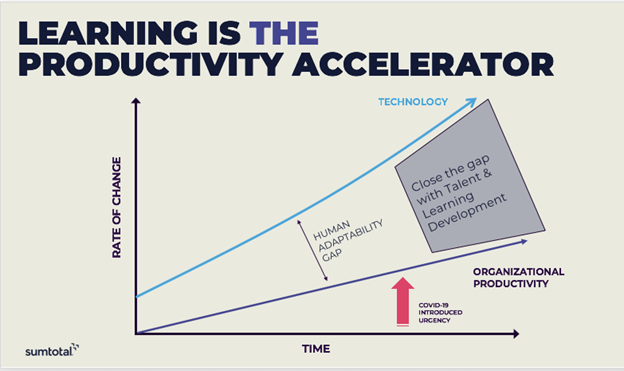Learning as a Pathway to Human Growth

No organization is assured a future. If the COVID-19 crisis has made anything clear, it’s that people and organizations must adapt to a changing world to survive. Those that do so quickly and effectively often dominate their markets.
We see evidence in the organizations that have already started to innovate rapidly over the past few years. Their embrace of digital transformation has positioned them for sustainability – and to overtake industry giants.
Consider that the average lifespan of market behemoths has rapidly dropped in the past few years. According to McKinsey, the average corporate life span was 61 years in 1958, 25 years in 1980, and 18 years in 2011. At this rate, McKinsey believes that 75% of the companies on the S&P 500 will have disappeared by 2027. In fact, 30% of the largest brands were replaced on the Dow Jones Industrial Average in recent years.
This illuminates the urgency of getting digital transformation right. Many business leaders get hung up on the “digital” (i.e., technology) aspect of “digital transformation,” but the essence of it is enabling people’s ability to execute in one of two forms:
- Linear (e.g., checking airline tickets on a phone)
- Exponential (i.e., changing the way of doing business)
Investors reward the latter. And success here requires the right talent with the ability to execute effectively.
Unfortunately, while the technology maturity curve continues to follow Moore’s Law, people’s productivity – or execution maturity – has stayed relatively flat. This is because people haven’t taken full advantage of these technological advances, partly because of lagging organizational HR maturity and readiness.

The implementation and adoption of new technologies has largely tracked to Moore’s Law, which posited that computing would dramatically increase in power and decrease in relative cost at an exponential pace. Leading economists credit the information technology made possible by integrated circuits with a third of U.S.A. productivity growth since 1974.
But there’s another law at play when it comes to business productivity: the Solow Paradox. In 1987, Robert Solow pointed out that productivity hadn’t kept pace with technological advances. Consider that the United States achieved an annual 2.5% productivity growth in the late 1990s and early 2000s, but only a 0.5% annual average in recent years.
Visionaries like Amazon, Uber, SpaceX, and Tesla – to name a few – have figured out how to ensure their people leverage technology to realize their optimal potential. It’s one reason we see upstarts displace established companies across industries at a rapid pace.
The COVID-19 Fallout: Organizational Maturity is Exposed
While digital transformation initiatives got underway for companies across industries pre-COVID-19, they lacked urgency. Once COVID -19 struck, some companies blew past digital resistance in record time to enable their newly remote workforce and ongoing innovation. For those in industries like manufacturing, nuclear energy, and others, the digital shift has been more measured since many of these workers are required on site.
Regardless of industry, the imperative is to create a digital organization focused on the future of work. People must be better equipped digitally. And it’s on HR to create the link between the technology and their people.
As the Fosway Group – an HR industry analyst focused on next-gen HR – underscores, “For much of the past 10 years, talent management has focused on a limited number of high potentials and the top 250 employees. But the COVID-19 crisis has made talent an enterprise-wide issue. Democratizing talent growth from the roots up is now key to optimizing employees’ value to an organization when and where it is most needed.”
Human Capital Management (HCM) technologies have evolved – think talent management, talent science (i.e., analytics), learning experience platforms, program experience platforms, and adoption workflow tools. But because HR has historically lacked the investment and organizational support to keep pace, it is now scrambling to build out the ecosystem. Simply put, digital acceleration is a must for enabling a resilient workforce and organization. Moreover, it can pave the way for a true competitive advantage.
Recent research found that HR organizations emphasizing the education and support of employees to increase their agility and productivity are more resilient. The same study reveals that the organizations further transforming themselves are resilient to disruptions and lead their industries. In these organizations, HR leads transformational change by leveraging
full-stack HR capabilities and embeds worker-driven, experiential learning built into the culture. In turn, the business is more likely to accomplish the outstanding outcomes shown below.

Source: https://joshbersin.com/business-resilience-the-global-covid-19-pandemic-response-study/
To be agile and adapt quickly, organizations must empower their individuals and provide experiences that make the complex simple. Do so effectively, and it’s faster to develop employee skills, knowledge, and behaviors and change policies and processes in line with changing market conditions faster.
Learning and Development is the Accelerator
Without a doubt, COVID-19 complicated business operations and introduced uncertainty about how to work. When COVID-19 reared its ugly head, some organizations furloughed employees – in some cases, at massive rates. How do organizations know who to furlough? Are they sure they can sustain their business with the remaining employees, many of whom have assumed additional responsibilities?
The key is for organizations to evolve their people’s behaviors and skills to fully embrace what is needed to sustain, innovate, collaborate, and more. It requires matching human adaptability to human-enabling technology.
Learning supports and accelerates growth and rapidly closes the gap between technology and human adaptability. But we’re not talking about the learning of yesteryear.
A Framework of Adaptability, Agility, and Resilience
In the past, employee performance and learning were separate. Now the lines between traditional talent and learning are gone: organizations can’t develop someone isolated from their potential.
Today organizations and their managers must give people continuous feedback in the flow of work so they can adjust on the fly. As they provide that feedback, managers must support their people in changing their behaviors and developing skills and knowledge. This involves delivering the applicable development resources associated with the desired action or behavior in the moment. The most effective approach is enabling this within a framework of adaptability, agility, and resilience.
- Adaptability: When an organization can adjust its approach or actions in response to changes in the external environment, it is adaptable. Adaptability translates to engaging current workers in a new, challenging environment, and easily evolving the workforce to execute in the face of new demands.
- Agility: The more quickly organizations can support an employee’s complete lifecycle , the faster the business can adjust to new market conditions. To enable this, managers need data that provides insight into their people and their potential. Specifically, organizations need to understand employees’ skills, attributes, aspirations – e.g., speaks three languages, is willing to travel, is interested in new roles, etc. – and map these to outcomes the business wants to achieves
Matching employee profiles and attributes with assessments for a well-rounded view of employees is a complex task, but an important one as businesses decide who to place where. Leveraging AI-like consumer tools can supply managers with these insights and simplify a complicated task. - Resilience. Business continuity planning needs to happen quickly. We’re in the accelerated digital transformation phase, with no luxury for three-to-five year plans. Organizations need to sustain and recover through this period and build upon their current positions. Succession planning is critical. Effective planning today requires looking at employee skills, assessments, performance, 360° assessments, participation in social communities, and more to build the next layer of leaders.
It Requires Simpler Tasks and User-Friendly Experiences
The concept of simplifying the complex is inherent in enabling this adaptability, agility, and resilience. Organizations can call upon numerous tools to close the skills gap today: LMS platforms, content libraries, micro-learning platforms, learning record stores, learning experience and program experience platforms, assessment development, and digital adoption and learning workflow tools.
But those products can create more complexity: eight different products translates to eight different integration points, maintenance tasks, and user experiences.
Moreover, it’s not sufficient to simply close the skills gap.
Meaningful transformation demands a new skilling strategy, where skills – along with knowledge and behaviors – make up employee readiness. Today’s employees need different abilities and skills – such as communication and languages – depending on their work. They also need competency in the form of the knowledge and behaviors to succeed in their roles.
The Fosway Group weighs in: “One of the biggest weaknesses of the [talent management provider] market has been the separation of people insights from wider talent processes. As we look to the future, we need to work harder to tear down the divides between people, process, and business data.”
Taking advantage of the right technology, organizations can navigate this triad of needs effectively and efficiently – especially critical as they take steps to enable the new roles that have arisen in the wake of COVID-19. Quickly figuring out and developing these new roles will be the key to a sustainable future.
The organizations that enable their people to develop, learn, and grow in lockstep with today’s business climate can outsmart competitors, sell better, and better serve customers – shoring up their sustainability in the process.
To determine your organization’s readiness for using learning as an accelerator, please reach out for a no-obligation consultation.
